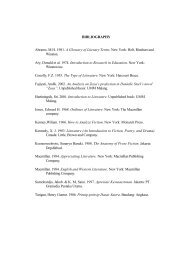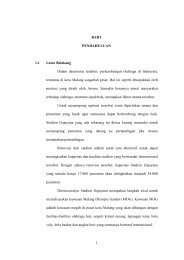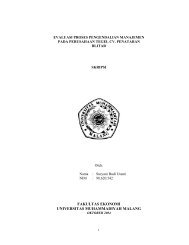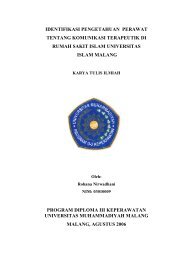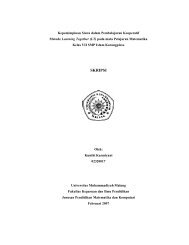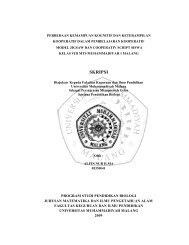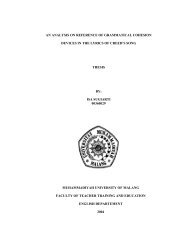File : THESIS.pdf - Universitas Muhammadiyah Malang
File : THESIS.pdf - Universitas Muhammadiyah Malang
File : THESIS.pdf - Universitas Muhammadiyah Malang
Create successful ePaper yourself
Turn your PDF publications into a flip-book with our unique Google optimized e-Paper software.
quantity and unit where appropriate. Similarly they should be able to<br />
construct suitable graphs displaying the independent variable on the xaxis<br />
and dependent variable on the y-axis, and fulfilling the criteria laid out in<br />
the Paper 3 section above, additionally including confidence limit error bars<br />
calculated using standard error.<br />
Candidates should know how to select and carry out the key steps of<br />
statistical methods designed to assess variability in data including<br />
range,<br />
inter-quartile range,<br />
standard deviation,<br />
standard error.<br />
Candidates should be able to select and use, when provided with<br />
suitable equations, statistical tests designed to find the differences between<br />
samples:<br />
chi squared test,<br />
standard error,<br />
t-test.<br />
see Notes on the Use of Statistics in Biology before the Glossary at<br />
the end of this syllabus.<br />
Evaluation<br />
Candidates should be able to:<br />
• Identify anomalous values in provided data and suggest appropriate<br />
means of dealing with such anomalies<br />
• Within familiar contexts, suggest possible explanations for anomalous<br />
readings;<br />
• Identify the extent to which provided readings have been adequately<br />
replicated, and describe the adequacy of the range of data provided;<br />
• Use provided information to assess the extent to which selected<br />
variables have been effectively controlled;<br />
• Use these evaluations and provided information to make informed<br />
judgements on the confidence with which conclusions may be drawn;<br />
In a table or graph of data, candidates should be able to identify values which<br />
are clearly anomalous, and suggest strategies for dealing with such anomalies,<br />
including repeating the experiment or omitting the affected replicate.<br />
Where investigations are set in familiar contexts, that it is expected that<br />
candidates will have explored during the course<br />
(those marked * in the syllabus content), candidates may be asked to<br />
suggest possible causes for such anomalies (above and beyond ‘investigator<br />
error’), and will be rewarded for answers derived from their own<br />
experience of problems intrinsic in the particular investigation.<br />
Candidates will be expected to have a knowledge of the advantages of<br />
replication of data, and the practical limitations. Candidates will be expected<br />
to be able to identify instances where it would have been sensible for the<br />
investigator to take readings at lower or higher values of the independent<br />
variable in order to give a complete range of values, and also situations<br />
where there are gaps in the range that reduce the information that can<br />
be provided from the investigation (e.g. around a key turning point).<br />
Candidates may be provided with information that will permit them to assess<br />
the extent to which a particular variable have been effectively controlled (e.g.<br />
the temperature recorded within each of a number of samples in which it is<br />
supposed to be the same).<br />
Candidates should be able to draw together all of this information to<br />
make informed judgements about the reliability of the investigation and the<br />
confidence with which the hypothesis may be tested.<br />
Conclusions<br />
Candidates should be able to:<br />
• draw conclusions from an investigation, providing a detailed description<br />
of the key features of the data and analyses, and considering whether<br />
experimental data supports a given hypothesis;<br />
131



